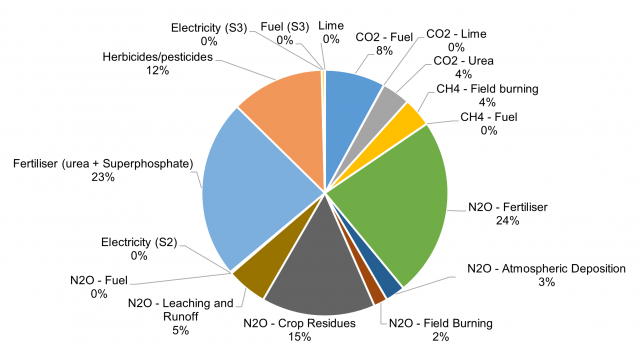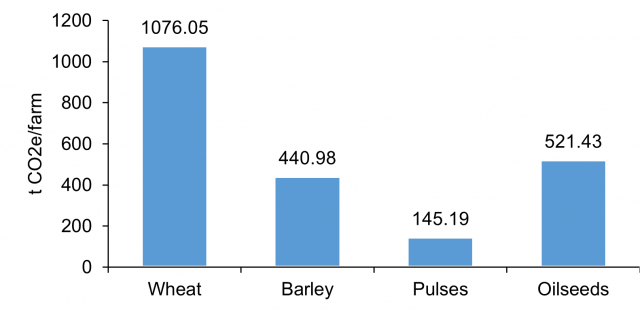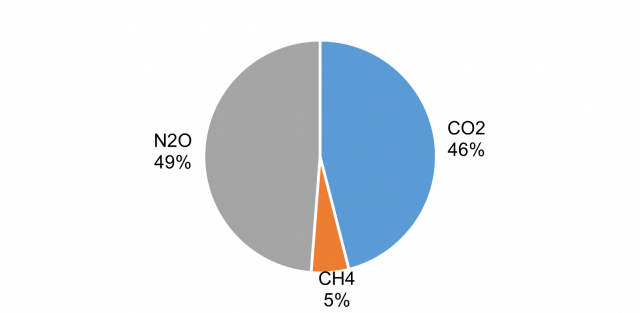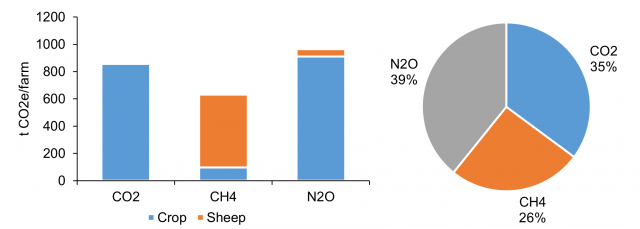Eastern Wheatbelt
The Eastern Wheatbelt of WA is characterised by low rainfall, low input farming. These farms are generally larger in hectares and have a larger cropping enterprise compared to livestock, with some farms out of livestock completely. Average annual rainfall is 290mm, with 154mm average growing season (April to September). Farm sizes generally range from 4000 to 6000ha arable land. The most common crops grown are wheat, barley, canola with some pulses and legumes also grown.

Eastern Wheatbelt 100% cropping
The 100% cropping example is in the agro-ecological zone L3, near Merredin (Figure 2). It is in a low rainfall (154mm growing season) region and the farm has 4900ha of arable land. Approximately 70% of the annual rotation is sown to cereals (wheat and barley), 20% to oilseeds (canola) and 10% to pulses. The input summary outlines the key inputs used for the carbon calculations (table 2).
| Input Summary |
| Wheat | Barley | Pulse | Oilseed |
| Average grain yield (t/ha) | 1.50 | 1.60 | 1.20 | 0.75 | |
| Area sown (ha/farm) | 2500 | 900 | 500 | 1000 | |
| Nitrogen Fertiliser Use (kg N/ha) | 33 | 33 | 0 | 33 | |
| Urea Application (included in the above) (kg Urea/ha) | 25 | 25 | 0 | 25 | |
| Mass of Lime Applied (kg/ha) | 1000 | 1000 | 0 | 0 | |
| Fraction of the annual production of crop that is burnt (F) (ha/total crop ha) | 0.05 | 1.00 | 0 | 1.00 | |
| Herbicide/Pesticide use (kg total) | 7715 | 2777 | 2461 | 5375 | |
| Single Superphosphate (kg/ha) | 87 | 87 | 87 | 87 | |
| Annual Diesel Consumption (L/year) | 55646 | 20032 | 11129 | 22259 |
In this 100% cropping example fertiliser and fuel were two of the largest scope 1 emission contributors (figure 3, see appendix A).
The net farm emissions totalled 2184 t CO2-e/farm. Most of the emissions produced by the wheat crop enterprise, which is to be expected as it is the largest proportion of crop grown (figure 4).
The oilseed (canola) crops had the highest emission intensity, whereas the other crops were all reasonably comparable (figure 5).
The CO2-e (CO2 equivalent) emissions were heavily weighted toward carbon dioxide (49%), and nitrous oxide (46%), with very little methane (5%) emissions (figure 6). This is to be expected when sheep are not part of the business.
Eastern Wheatbelt mixed farm
The Eastern Wheatbelt mixed farm example has been based in the same zone as the 100% cropping example (L3, figure 2), with the same low rainfall restraint. The farm has 5000ha of arable land and is an 85% cropping 15% sheep enterprise (4200ha cropping, 800ha pasture). The farm runs a self-replacing merino ewe flock of 1200 ewes. Lambing occurs in June and lambs are turned off before harvest. The farm achieves a 90% lambing rate, and no crop grazing occurs. Pastures are low/no input and often used as breaks or fallows for the cropping rotations, improved pastures are not commonly grown.
The crop proportions are the same as used in the Eastern Wheatbelt 100% cropping, just at reduced hectares to allow for the pasture phase (table 3).
| Input Summary |
| Wheat | Barley | Pulse | Oilseed |
| Average grain yield (t/ha) | 1.50 | 1.60 | 1.20 | 0.75 | |
| Area sown (ha/farm) | 2200 | 750 | 400 | 850 | |
| Nitrogen Fertiliser Use (kg N/ha) | 30 | 30 | 0 | 30 | |
| Urea Application (included in the above) (kg Urea/ha) | 25 | 25 | 0 | 25 | |
| Mass of Lime Applied (kg/ha) | 1000 | 1000 | 0 | 0 | |
| Fraction of the annual production of crop that is burnt (F) (ha/total crop ha) | 0.05 | 1.00 | 0.00 | 1.00 | |
| Herbicide/Pesticide use (kg total) | 7715 | 2777 | 2461 | 5375 | |
| Single Superphosphate (kg/ha) | 87 | 87 | 87 | 87 | |
| Annual Diesel Consumption (L/year) | 55646 | 20033 | 11129 | 22259 |
The largest contributor to emissions in this mixed system was enteric methane (21%) and fertilisers (N2O fertiliser 18%, scope 3 fertilisers 18%) (see appendix A).
The net farm emissions totalled 2480 t CO2-e/farm. With largest proportion of the emissions coming from the wheat crops, followed by the sheep (figure 7).
The emission intensities for the cropping enterprise were the same as the 100% cropping Eastern Wheatbelt farm (figure 5). The sheep aspect of the enterprise observed an emission intensity of 8.10 kg CO2-e/ kg for meat and 29.40 kg CO2-e/ kg greasy for wool (see appendix A).
As to be expected the sheep enterprise contributed largely to the total methane CO2-e emissions compared to cropping and contributed little to the carbon dioxide and nitrous oxide emissions. Overall, 39% of the emissions were from carbon dioxide, 35% from nitrous oxides and 26% from methane (figure 8).
The GAF tools used for these calculations are freely available here to run your own farm.






